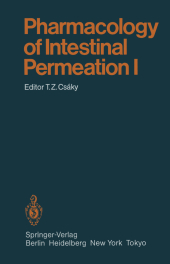 Neuerscheinungen 2012Stand: 2020-01-07 |
Schnellsuche
ISBN/Stichwort/Autor
|
Herderstraße 10
10625 Berlin
Tel.: 030 315 714 16
Fax 030 315 714 14
info@buchspektrum.de |

W. McD. Armstrong
Pharmacology of Intestinal Permeation I
Collab. by W. McD. Amstrong
Softcover reprint of the original 1st ed. 1984. 2012. xx, 708 S. XX, 708 pp. 164 figs. 242 mm
Verlag/Jahr: SPRINGER, BERLIN 2012
ISBN: 3-642-69507-8 (3642695078)
Neue ISBN: 978-3-642-69507-0 (9783642695070)
Preis und Lieferzeit: Bitte klicken
The intestine, particularly the small bowel, represents a large surface (in the adult 2 human approximately 200m ) through which the body is exposed to its environment. A vigorous substrate exchange takes place across this large surface: nutrients and xenobiotics are absorbed from the lumen into the bloodstream or the lymph, and simultaneously, the same types of substrate pass back into the lumen. The luminal surface of the intestine is lined with a "leaky" epithelium, thus the passage of the substrates, in either direction, proceeds via both transcellular and intercellular routes. Simple and carrier-mediated diffusion, active transport, pinocytosis, phagocytosis and persorption are all involved in this passage across the intestinal wall. The term "intestinal permeation" refers to the process of passage of various substances across the gut wall, either from the lumen into the blood or lymph, or in the opposite direction. "Permeability" is the condition of the gut which governs the rate of this complex two-way passage. The pharmacologist´s interest in the problem of intestinal permeation is twofold: on the one hand, this process determines thebioavailability of drugs and contributes significantly to the pharmacokinetics and toxicokinetics of xeno biotics; on the other hand, the pharmacodynamic effects of many drugs are manifested in a significant alteration of the physiological process of intestinal permeation.


